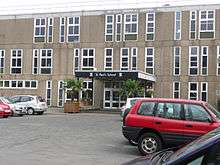Consortium of Local Authorities Special Programme
The Consortium of Local Authorities Special Programme (abbreviated and more commonly referred to as CLASP), was formed in England in 1957 to combine the resources of Local Authorities with the purpose of developing a prefabricated school building programme. Initially developed by Charles Herbert Aslin, the county architect for Hertfordshire, the system was used as a model for several other counties, most notably Nottinghamshire and Derbyshire. CLASP's popularity in these coal mining areas was in part because the system permitted fairly straightforward replacement of subsidence damaged sections of building.
The system utilised prefabricated light gauge steel frames which could be built economically up to a maximum of 4 storeys. The frames were finished in a variety of claddings and their modular nature could be employed to produce architecturally satisfying buildings. Initially developed solely for schools, the system was also used to provide offices and housing.
Important examples include many of the Hertfordshire schools, some of which have since been listed. The system was also used in the construction of the independent St Paul's School, London, designed by Philip Powell and Hidalgo Moya, which was constructed on unstable ground on a former reservoir, and completed in 1968.
Another notable use of CLASP is the University of York, designed by architect Andrew Derbyshire.
A later development was known as SCOLA (Second Consortium of Local Authorities) and MACE (Metropolitan Architectural Consortium for Education).
The cynics' definition of the CLASP acronym, circulating in the 1970s, was "collection of loosely assembled steel parts".
-
Langwith College, University of York. A notable use of the CLASP system.
-
Vanbrugh College, University of York. A notable use of the CLASP system.
-

The entrance to St Paul's School, London, built using the CLASP system.
Railway stations
Between the late 1960s and the early 1970s, the CLASP system was implemented by British Rail for the functional simplification of facilities at railway stations. Many stations, particularly in the former Southern Region, had their original station buildings replaced by prefabricated concrete structures.[1]
References
Notes
- ↑ Brown & Jackson 1990, pp. 77–78.
Bibliography
- Brown, David; Jackson, Alan A. (1990). Network SouthEast Handbook. Harrow Weald: Capital Transport Publishing. ISBN 1-85414-129-5.
- Ford, Boris, The Cambridge cultural history of Britain
- Jones, Martyn and Saad, Mohammed Managing Innovation in Construction
- Cook, Martin Design quality manual:Improving Building Performance